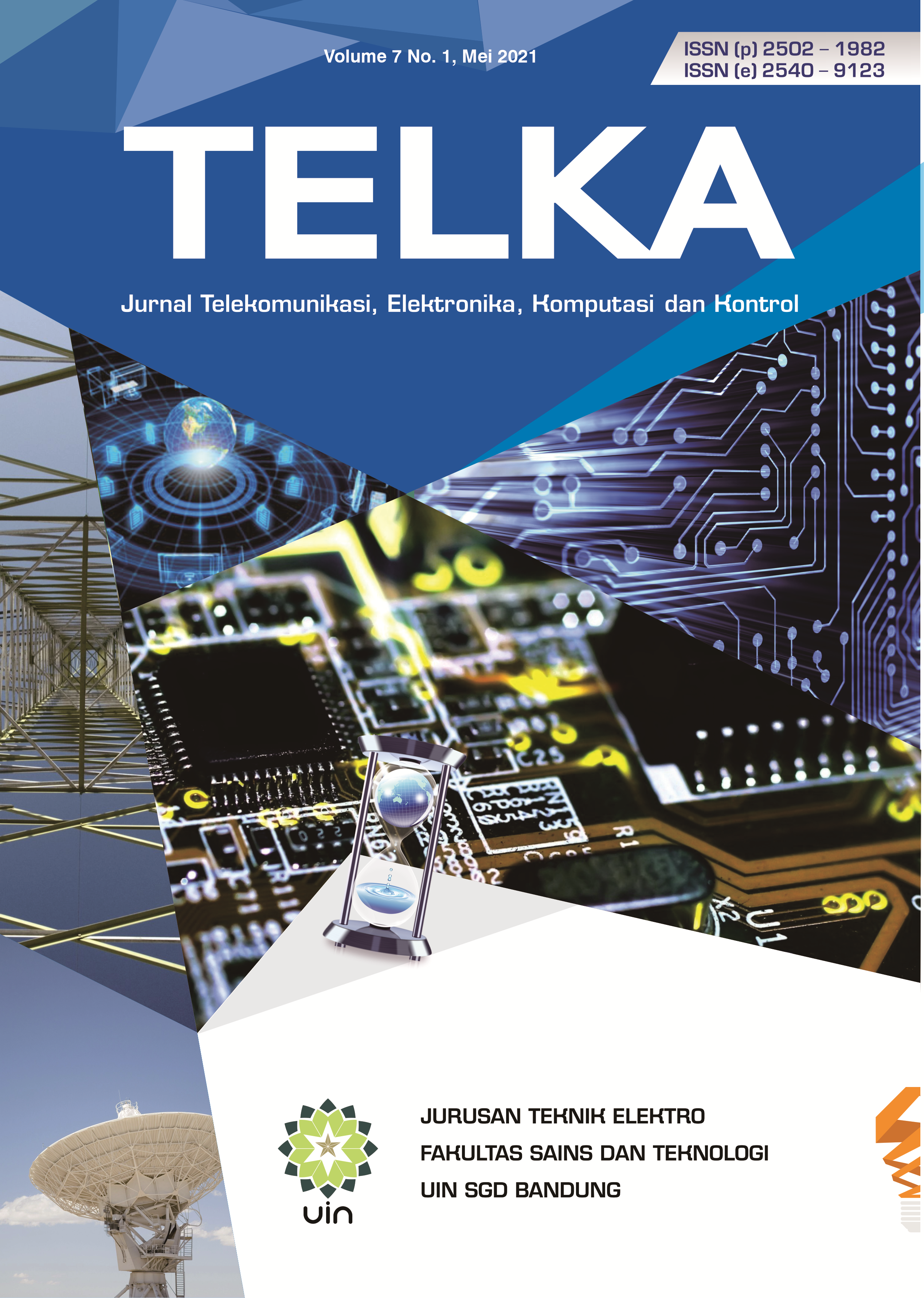Kendali Posisi Motor DC Menggunakan Logika Fuzzy Interval Tipe 2
DOI:
https://doi.org/10.15575/telka.v7n1.1-10Kata Kunci:
kendali posisi, IT2FL, derau, FoU, ketidakpastian parameterAbstrak
Kendali posisi motor DC sangat diperlukan dalam berbagai sistem dinamik. Karaketristik kekokohan pengendalian menjadi salah satu hal yang harus dipertimbangkan dalam pengendalian posisi motor DC. Makalah ini bertujuan untuk mengusulkan metode pengendalian posisi motor DC menggunakan kendali Interval Type 2 Fuzzy Logic (IT2FL). Berbeda dengan pengendali logika fuzzy tipe 1, pengendali ini memiliki fungsi keanggotaan dengan Footprint of Uncertainty (FoU) di setiap variabel linguistik. Kelebihan inilah yang menyebabkan kendali logika fuzzy tipe 2 memiliki karakteristik kekokohan terhadap ketidakpastian parameter sistem. Penelitian ini menggunakan simulasi Matlab/Simulink untuk menunjukkan respon pengendalian dengan penambahan sinyal derau dan dua skenario FoU. Hasil simulasi menunjukkan bahwa pengendali IT2FL menghasilkan performa lebih baik dibandingkan pengendali logika fuzzy tipe 1 dalam mengatasi derau pengukuran. Pada pengendali IT2FL, FoU 0,2 menghasilkan integral error yang lebih kecil dibandingkan FoU 0,1 dengan selisih terkecil sebesar 0,001.
Position control of DC motor is indispensable in various dynamic systems. Control robustness characteristics are one of the things that must be considered in controlling the position of a DC motor. This paper aims to propose a DC motor position control method using an Interval Type 2 Fuzzy Logic (IT2FL) controller. Unlike the type 1 fuzzy logic controller, this controller has a membership function with a Footprint of Uncertainty (FoU) in each linguistic variable. The benefits of it cause the type 2 fuzzy logic control to have robust characteristics against the uncertainty of system parameters. This study uses a Matlab / Simulink simulation to show the control response with the addition of a noise signal and two FoU scenarios. The simulation results show that the IT2FL controller produces better performance than the type 1 fuzzy logic controller in overcoming measurement noise. In the IT2FL controller, FoU 0.2 produces an integral error that is smaller than FoU 0.1 with the smallest difference of 0.001.
Referensi
R. Muhardian and K. Krismadinata, “Kendali Kecepatan Motor DC Dengan Kontroller PID dan Antarmuka Visual Basic,” JTEV (Jurnal Teknik Elektro dan Vokasional), vol. 6, no. 1, pp. 328-339, 2020.
M. Asbi, S. Subiyanto, and Y. Primadiyono, “Simulasi Kendali Motor DC Penguat Terpisah Menggunakan Kendali Fuzzy-FOPID,” Jetri: Jurnal Ilmiah Teknik Elektro, vol. 17, no. 1, pp. 99-116, 2019.
Z. Tir, O. Malik, M. A. Hamida, H. Cherif, Y. Bekakra and A. Kadrine, “Implementation of a fuzzy logic speed controller for a permanent magnet dc motor using a low-cost Arduino platform,” 2017 5th International Conference on Electrical Engineering - Boumerdes (ICEE-B), Boumerdes, 2017, pp. 1-4.
Q. Hidayati and M. E. Prasetyo, “Pengaturan Kecepatan Motor DC dengan Menggunakan Mikrokontroler Berbasis Fuzzy-PID,” JTT (Jurnal Teknologi Terpadu), vol. 4, no. 1, pp. 12-17, 2014.
A. Ma'arif and N. R. Setiawan, “Control of DC Motor Using Integral State Feedback and Comparison with PID: Simulation and Arduino Implementation,” Journal of Robotics and Control (JRC), vol. 2, no. 5, pp. 456-461, 2021.
E. W. Sinuraya, “Pemodelan Dan Simulasi Motor Dc Dengan Kendali Model Predictive Control (MPC),” Transmisi, vol. 14, no. 3, pp. 91-96, 2012.
J. Chotai and K. Narwekar, “Modelling and position control of brushed DC motor,” 2017 International Conference on Advances in Computing, Communication and Control (ICAC3), Mumbai, 2017, pp. 1-5.
N. Dey, U. Mondal, and D. Mondal, “Design of a H-infinity robust controller for a DC servo motor system,” 2016 International Conference on Intelligent Control Power and Instrumentation (ICICPI), Kolkata, 2016, pp. 27-31.
F. Funk, T. Bucksch, and D. Mueller-Gritschneder, “ML Training on a Tiny Microcontroller for a Self-adaptive Neural Network-Based DC Motor Speed Controller,” in IoT Streams for Data-Driven Predictive Maintenance and IoT, Edge, and Mobile for Embedded Machine Learning, Springer, Cham, pp. 268-279, 2020.
I. Khadari, “Simulasi Kontroler Pid Tuning Menggunakan Logika Fuzzy dan Algoritma Genetika Sebagai Pengendali Kecepatan Motor DC,” Setrum: Sistem Kendali-Tenaga-elektronika-telekomunikasi-komputer, vol. 8, no. 2, pp. 186-196, 2019.
F. A. Hasan and L. J. Rashad, “Fractional-order PID controller for permanent magnet DC motor based on PSO algorithm,” International Journal of Power Electronics and Drive Systems, vol. 10, no. 4, pp. 1724, 2019.
S. K. Pradhan and B. Subudhi, “Position control of a flexible manipulator using a new nonlinear self-tuning PID controller,” IEEE/CAA Journal of Automatica Sinica, vol. 7, no. 1, pp. 136-149, 2018.
J. Bae, K. Cho, and D. Lee, “Parallel Position Control Scheme of Permanent Magnet DC Motors with a Low-Resolution Sensor,” 2020 IEEE International Conference on Industrial Technology (ICIT), Buenos Aires, Argentina, 2020, pp. 199-204.
M. H. Khamsehei Fadaei, S. Ghasem Rahmat Alhosseini Ghochan Atigh, A. Zalaghi, and Z. Torkani, “Design of Model Reference Adaptive Control for a 4-DOF Serial Manipulator,” 2019 5th Conference on Knowledge Based Engineering and Innovation (KBEI), Tehran, Iran, 2019, pp. 108-112.
S. A. Suhail, M. A. Bazaz, and S. Hussain, “Active disturbance rejection control applied to a DC motor for position control,” In Proceedings of ICETIT 2019, Springer, Cham, 2020, pp. 437-448.
A. Gundogdu, R. Celikel, O. Aydogmus, “Comparison of SI-ANN and Extended Kalman Filter-Based Sensorless Speed Controls of a DC Motor,” Arabian Journal for Science and Engineering, vol. 46, pp. 1241–1256, 2020.
M. A. Aravind, N. Saikumar, and N. S. Dinesh, “Optimal position control of a DC motor using LQG with EKF,” in 2017 international conference on mechanical, system and control engineering (ICMSC), 2017, pp. 149-154.
A. R. Al Tahtawi, “Kalman filter algorithm design for hc-sr04 ultrasonic sensor data acquisition system,” IJITEE (International Journal of Information Technology and Electrical Engineering), vol. 2, no. (1), pp. 15-19, 2018.
H. Hassani and J. Zarei, “Interval Type-2 fuzzy logic controller design for the speed control of DC motors,” Systems Science & Control Engineering, vol. 3, no. 1, pp. 266-273, 2015.
M. K. Asy'ari and A. Musyafa, “Design of Buck Converter Based on Interval Type-2 Fuzzy Logic Controller,” 2018 International Seminar on Intelligent Technology and Its Applications (ISITIA), Bali, Indonesia, 2018, pp. 153-156.
J. Al-Kausar, A. S. Handayani, and S. Sarjana, “Perbandingan Type-1 Fuzzy Logic System (T1FLS) dan Interval Type-2 Fuzzy Logic System (IT2FLS) pada Mobile Robot,” in Annual Research Seminar (ARS), vol. 4, no. 1, pp. 288-292, 2018.
N. Nafia, A. El Kari, H. Ayad, and M. Mjahed, “Robust interval type-2 fuzzy sliding mode control design for robot manipulators,” Robotics, vol. 7, no. 3, pp. 40, 2018.













